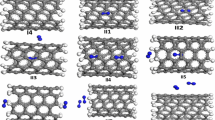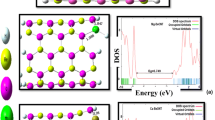Abstract
This study investigates the sensing capabilities of (8,0) SWCNTs in detecting formamide (HCONH2), a molecule crucial for the structure of proteins, nucleic acids, and certain anti-cancer drugs. Adsorption of HCONH2 on pristine SWCNT, Al- and N-doped SWCNT, and Al/N co-doped SWCNT was studied using dispersion-corrected density functional theory (DFT-D). Formamide was adsorbed from both oxygen and –NH2 sides, and the structures were fully optimization. The relaxed structures were applied for calculating magnetic and electronic properties like adsorption energies, band structures, and partial density of states. Most negative adsorption energy in doped structures indicates the strongest adsorption of formamide in doped structures than pristine SWCNT. The results also indicates that formamide adsorption does not change the electronic properties of pure SWCNT and N-doped SWCNT. However, it removes the band gaps of Al- and Al/N-doped SWCNT. Therefore, the modified nanotubes convert from semiconductor to metallic character which can be detected using electronic devices. Moreover, formamide adsorption induces some magnetization to Al-doped SWCNT and Al/N co-doped which can be utilized in spin transport devices. These findings suggest that Al/N co-doped and Al-doped SWCNTs are good candidates for detecting HCONH2 molecules.
Graphical abstract














Similar content being viewed by others
Data availability statement
All data, materials, and codes used in this work are strictly following their terms and conditions for publication.
References
N. Gupta, S. Gupta, M.S.K. Sharma, Carbon Lett. (2019). https://doi.org/10.1007/s42823-019-00068-2
K. Funayama, J. Hirotani, A. Miura, H. Tanaka, Y. Ohno, AIP Adv. 10(1063/5), 0058300 (2021)
X. He, H. Htoon, S.K. Doorn, W.H.P. Pernice, F. Pyatkov, R. Krupke, A. Jeantet, Y. Chassagneux, C. Voisin, Nat. Mater. (2018). https://doi.org/10.1038/s41563-018-0109-2
G.A. Rivas, M.C. Rodríguez, M.D. Rubianes, F.A. Gutierrez, M. Eguílaz, P.R. Dalmasso et al., Appl. Mater. Today (2017). https://doi.org/10.1016/j.apmt.2017.10.005
T. Han, A. Nag et al., Sens Actuator A Phys. (2019). https://doi.org/10.1016/j.sna.2019.03.053
M. Poonia, V. Manjuladevi, R.K. Gupta, S.K. Gupta, J. Singh, P.B. Agarwa, J. Akhta, Sci. Adv. Mater. (2015). https://doi.org/10.1166/sam.2015.1989
S. Demir, M.F. Fellah, Appl. Surf. Sci. (2020). https://doi.org/10.1016/j.apsusc.2019.144141
R. Chadar, O. Afzal, Colloids Surf. B (2021). https://doi.org/10.1016/j.colsurfb.2021.112044
M.S. Parvaiz, K.A. Shah, H. Alrobei, G.N. Dar, F.A. Khanday, S. Muzaffar Ali Andrabi et al., Comput. Theor. Chem.. Theor. Chem. (2021). https://doi.org/10.1016/j.comptc.2021.113402
V. Schroeder, S. Savagatrup, T.M. Swager, Chem. Rev. (2018). https://doi.org/10.1021/acs.chemrev.8b00340
Y. Seekaew, A. Wisitsoraat, C. Wongchoosuk, Diam. Relat. Mater. (2023). https://doi.org/10.1016/j.diamond.2022.109630
N. Saikia, R.C. Deka, J. Mol. Model. (2013). https://doi.org/10.1007/s00894-012-1534-9
Y. Li, M. Hodak, W. Lu, J. Bernholc, Carbon (2016). https://doi.org/10.1016/j.carbon.2016.01.092
T. Chen, L. An, X. Jia, J. Mol. Model. (2021). https://doi.org/10.1007/s00894-021-04683-7
R. Behjatmanesh-Ardakani, P. Nazari, Appl. Surf. Sci. (2022). https://doi.org/10.1016/j.apsusc.2021.152217
N. Karimi, J.J. Sardroodi, A.E. Rastkar, J. Mol. Model. (2022). https://doi.org/10.1007/s00894-022-05296-4
N.S. Anas, R.K. Dash, T.N. Rao, R. Vijay, J. Mater. Eng. Perform. (2017). https://doi.org/10.1007/s11665-017-2730-7
M.D. Esrafili, S. Heydari, L. Dinparast, Struct. Chem. (2019). https://doi.org/10.1007/s11224-019-01355-4
X. Zhou, C. Zhao, C. Chen, J. Chen, Y. Li, Appl. Surf. Sci. (2020). https://doi.org/10.1016/j.apsusc.2020.146595
J. Deb, D. Paul, U. Sarkar, P.W. Ayers, J. Mol. Model. (2018). https://doi.org/10.1007/s00894-018-3793-6
İ Muz, S. Alaei, M. Kurban, Mater. Today Commun. (2021). https://doi.org/10.1016/j.mtcomm.2021.102252
İ Muz, H. Kurban, M. Kurban, Mater. Today Commun. (2021). https://doi.org/10.1016/j.mtcomm.2021.102118
M.A. Azam, F.M. Alias, L.W. Tack, J. Mol. Graph. (2017). https://doi.org/10.1016/j.jmgm.2017.05.003
F.K. Fotooh, M. Nayeri, Surf. Sci. (2021). https://doi.org/10.1016/j.susc.2021.121913
X. Jia, L. An, T. Chen, Adsorption (2020). https://doi.org/10.1007/s10450-020-00218-3
S. Jalili, M. Jafari, J. Habibian, J. Iran. Chem. Soc. (2008). https://doi.org/10.1007/BF03246145
N. Dwivedi, R.K. Shukla, S.N. Appl, Science (2020). https://doi.org/10.1007/s42452-020-2055-2
M. Hamadanian, F.K. Fotooh, Comput. Mater. Sci. (2014). https://doi.org/10.1016/j.commatsci.2013.10.021
G. Costanzo, R. Saladino, C. Crestini, F. Ciciriello, E. Di Mauro. (2007). https://doi.org/10.1186/1471-2148-7-S2-S1
J. Shi, Z. Lou, M. Yang, Y. Zhang, H. Liu, Y. Meng, Surf. Sci. (2014). https://doi.org/10.1186/1471-2148-7-S2-S110.1016/j.susc.2014.01.019
İ Muz, F. Göktaş, Physica E Low Dimens. Syst. Nanostruct. (2022). https://doi.org/10.1016/j.physe.2021.114950
M. Afshar, R.R. Khojasteh, R. Ahmadi, Nanotubes in drug. Chem. Commun. (2020)
J. Kaur, G.S. Gill, K. Jeet, Characterization and biology of nanomaterials for drug delivery (2019). https://doi.org/10.1016/B978-0-12-814031-4.00005-2
İ Muz, Mater. Today Commun. (2022). https://doi.org/10.1016/j.mtcomm.2022.103798
M. Kurban, İ Muz, J. Mol. Liq. (2020). https://doi.org/10.1016/j.molliq.2020.113209
İ Muz, M. Kurban, J. Mol. Liq. Mol. Liq. (2021). https://doi.org/10.1016/j.molliq.2021.116181
A. Hosseinian, E. Vessally, A. Bekhradnia, K. Nejati, G. Rahimpour, Thin Solid Films (2017). https://doi.org/10.1016/j.tsf.2017.08.049
P.R. McGill, T. Söhnel, J. Phys. Chem. C (2012). https://doi.org/10.1021/jp302729e
W. Reckien, B. Kirchner, F. Janetzko, T. Bredow, J. Phys. Chem. C (2009). https://doi.org/10.1021/jp811146m
W. Reckien, B. Kirchner, F. Janetzko, T. Bredow, Surf. Sci. (2009). https://doi.org/10.1016/j.susc.2012.09.006
B. Kiss, S. Picaud, M. Szőri, P. Jedlovszky, J. Phys. Chem. A. (2019). https://doi.org/10.1021/acs.jpca.9b00850
M.D. Esrafili, R.V. Nurazar, Surf. Sci. (2015). https://doi.org/10.1016/j.susc.2015.03.015
M.D. Esrafili, F.A. Rad, J. Mol. Graph. Model. (2018). https://doi.org/10.1016/j.jmgm.2018.04.004
P. Giannozzi, O. Andreussi, T. Brumme, O. Bunau, M.B. Nardelli, M. Calandra, S. Baroni, J. Phys. Condens. Matter (2017). https://doi.org/10.1088/1361648X/aa8f79
S. Grimme, J. Comput. Chem. (2006). https://doi.org/10.1002/jcc.20495
K. Berland, V.R. Cooper, K. Lee, E. Schröder, T. Thonhauser, P. Hyldgaard, B.I. Lundqvist, Rep. Prog. Phys. (2015). https://doi.org/10.1088/0034-4885/78/6/066501
H.J. Monkhorst, J.D. Pack, Phys. Rev. B (1976). https://doi.org/10.1103/PhysRevB.13.5188
J. Rezac, P. Hobza, Chem. Rev. (2016). https://doi.org/10.1021/acs.chemrev.6b00247
F. Shiri, F. Kalantari Fotooh, M.H. Mosslemin, R. Mohebat, J. Mol. Model. (2021). https://doi.org/10.1007/s00894-021-04761-w
R. Wang, D. Zhang, W. Sun, Z. Han, C. Liu, J. Mol. Struct. Theochem. (2007). https://doi.org/10.1016/j.theochem.2006.11.012
M. Hamadanian, B. Khoshnevisan, F.K. Fotooh, Z. Tavangar, Comput. Mater. Sci.. Mater. Sci. (2012). https://doi.org/10.1016/j.commatsci.2012.01.001
J. Deb, B. Bhattacharya, N.B. Singh, U. Sarkar, Struct. Chem. (2016). https://doi.org/10.1007/s11224-016-0747-4
D.G. Nanotube, J. Deb, B. Bhattacharya, D. Paul, U. Sarkar, Graphyne nanotube. Phys. E Low-Dimens. Syst. (2016). https://doi.org/10.1016/j.physe.2016.08.006
J. Deb, D. Paul, D. Pegu, U. Sarkar, D.E.B. Jyotirmoy, P.A.U.L. Debolina, P.E.G.U. David, Acta Phys. Chim. Sin. (2018). https://doi.org/10.3866/PKU.WHXB201710161
F. Nattagh, S. Hosseini, M.D., J. Mol. Liq. (2021). https://doi.org/10.1016/j.molliq.2021.117459
Acknowledgements
The authors gratefully acknowledge the University of Yazd for providing computing facilities and time.
Funding
No funding was received to assist with the preparation of this manuscript.
Author information
Authors and Affiliations
Contributions
M. ghafari: software, investigation and interpretation of data, and writing and drafting the manuscript. H. Mohammadi-Manesh: conceptualization, interpretation of data, drafting the manuscript, revising the manuscript, and writing the text and the references of this work. F. Kalantari Fotooh: writing—review and editing.
Corresponding author
Ethics declarations
Conflict of interest
The authors declare no conflict of interest.
Rights and permissions
Springer Nature or its licensor (e.g. a society or other partner) holds exclusive rights to this article under a publishing agreement with the author(s) or other rightsholder(s); author self-archiving of the accepted manuscript version of this article is solely governed by the terms of such publishing agreement and applicable law.
About this article
Cite this article
Ghafari, M., Mohammadi-Manesh, H. & Fotooh, F.K. Adsorption of formamide on pure, Al-, N-doped, and Al/N co-doped (8, 0) single-wall carbon nanotubes: a DFT study. Eur. Phys. J. B 97, 38 (2024). https://doi.org/10.1140/epjb/s10051-024-00679-3
Received:
Accepted:
Published:
DOI: https://doi.org/10.1140/epjb/s10051-024-00679-3




